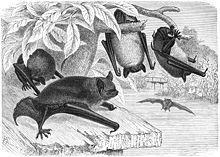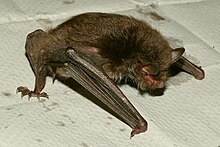Water bat
| Water bat | ||||||||||||
|---|---|---|---|---|---|---|---|---|---|---|---|---|

Water bat ( Myotis daubentonii ) in flight |
||||||||||||
| Systematics | ||||||||||||
|
||||||||||||
| Scientific name | ||||||||||||
| Myotis daubentonii | ||||||||||||
| ( Kuhl , 1817) |
The water bat ( Myotis daubentonii ) belongs to the smooth-nosed family of bats and owes its German name to its hunting behavior. It tracks its prey at a short distance above the surface of the water . Your scientific name honors the French zoologist Louis Jean-Marie Daubenton (1716–1799).
features
Their enormous feet are typical of water bats. The red-brown face, which is not very hairy, is also striking. With a wingspan of 24 cm to 27.5 cm and a weight of around 7 g to 15 g, they are among the medium-sized native species. It looks similar to the pond bat , but is slightly smaller.
Like all other mouse ears ( myotis ), the water bat also has an ear cover ( tragus ) that does not quite reach half the length of the ear. You will be around three years old.
The muscles that a water bat uses to generate sounds for echolocation can be tensed and relaxed up to 160 times per second, so that up to 160 calls per second can be generated.
Diet and hunting behavior
The name already reveals their preferred hunting area, because they are mostly on the move across bodies of water to catch flying insects. There are often several animals at the same time that hunt mainly for mosquitoes , but also other aquatic insects, at a low height of approx. 15 cm above the water surface . Insects that have fallen into the water and drifting on the surface of the water are also very skilfully scooped out with the tail skin and then picked up with the mouth for consumption from this flight skin pocket. With her big feet she is even able to catch small fish. A bat eats around a third of its body weight of around 10 g every night.
On the way to the hunting grounds, the animals prefer to use linear structures such as rows of trees or hedges as guidelines. Here the animals fly at around 25 km / h, while hunting at around 12 km / h.
Resting places
Diving bats usually hide in tree hollows in forests during the day . They always fly on the same “airlines” from their hiding places to the hunting area. In doing so, they follow well-known terrain structures, forest edges and hedges when flying low. From a tree cave in the forest, rarely in buildings, to the next river bank, this can easily be one to two kilometers. They leave their summer quarters to hunt in the late dusk. In winter, water bats gather in large groups in order to sleep through the insect-free season in frost-proof caves and crevices. Here, 100% humidity and 3–6 degrees Celsius are ideal. If the temperature falls permanently below 3 degrees, they move to a warmer quarter.
Reproduction and birth
Mating takes place in winter. The males look for the females and wake them up with a bite on the neck. When the females are awake, they are mated. Since the females are still in the waking phase during mating and are therefore weakened, courtship around the females is not necessary. After the act of mating, both animals look for a place to sleep again and continue their hibernation . The females are not fertilized immediately, but only towards the end of winter, when the pregnancy no longer draws too much energy. After the excursion, the pregnant females come together in nursery groups (20–50 per room) and then give birth to their offspring in the second half of June.
The animals will probably reach sexual maturity in the year of their birth . This is suspected because spermatozoa or severely swollen testicles and filled epididymis were found in males three to four months old .
distribution
The water bat colonizes large parts of the Palearctic from Ireland and Great Britain to Korea and Japan . The occurrence is essentially limited to the temperate climate zone.
threat

In contrast to many other bat species, the water bat is not included in the red list of endangered species because it occurs relatively frequently and its population is currently considered to be secure.
Web links
- Diving bat at the NABU Schleswig-Holstein
- Well illustrated page on bogon-naturfoto.de
- Water bat on Fledermausfreundliches-Haus.de
- IUCN
Individual evidence
- ↑ Klaus Richarz. Observe, recognize and protect bats. Franckh-Kosmos , Stuttgart 2004 ISBN 978-3-440-09691-8 p. 106
- ↑ Coen PH Elemans et al .: Superfast Muscles set maximum call rate in echolocating bats. In: Science , Volume 333, No. 6051, 2011, pp. 1885-1888, DOI: 10.1126 / science.1207309
- ↑ Water bat (Myotis daubentonii). (No longer available online.) Federal Agency for Nature Conservation, archived from the original on April 17, 2016 ; Retrieved April 17, 2016 . Info: The archive link was inserted automatically and has not yet been checked. Please check the original and archive link according to the instructions and then remove this notice.


